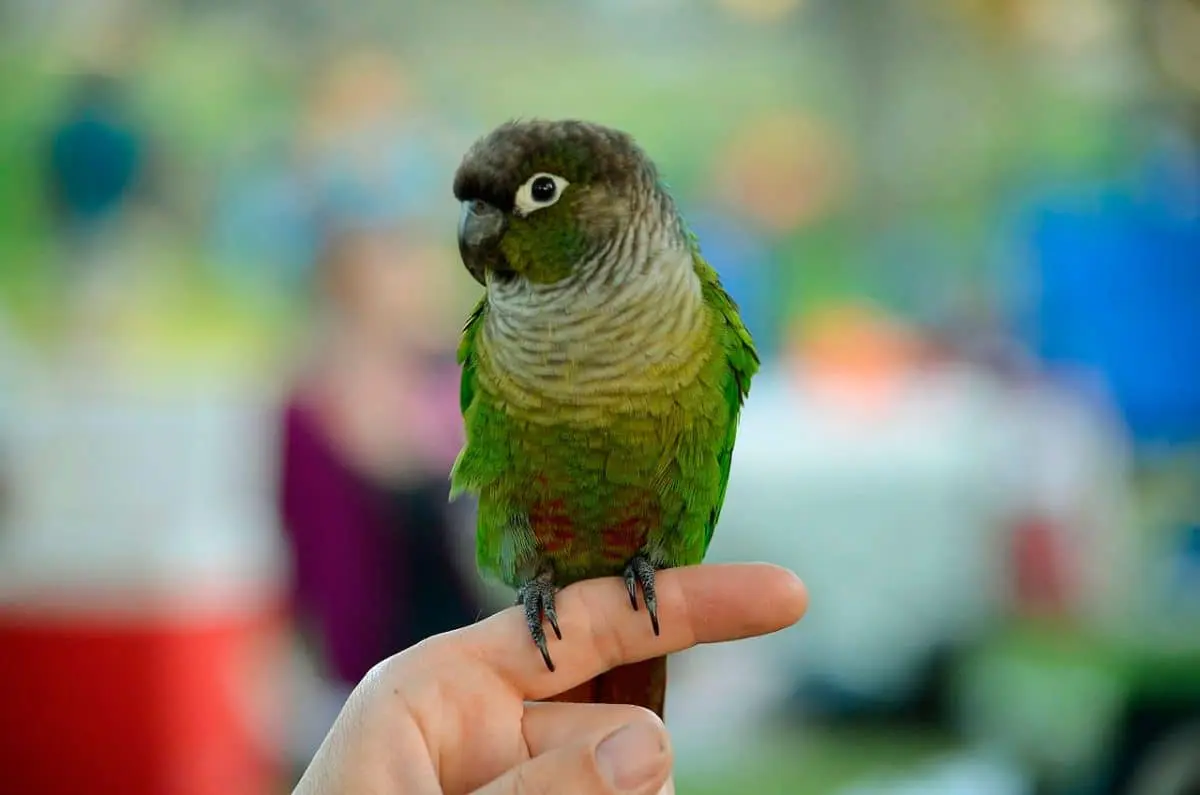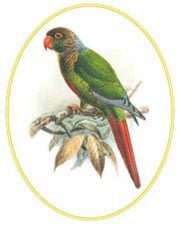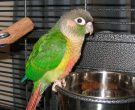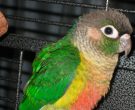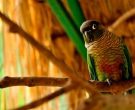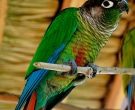Content |
|---|
Description:
25 cm.. in length and 62–81 grams in weight.
The Green-cheeked Parakeet (Pyrrhura molinae) has a close frontal band and lores, you are reddish brown to blackish; crown, of color brown or brown grayish marked laterally in shades blue and green; rear area of the crown and nape with blue tips; cheeks and sometimes the supercilii area (area of the front), of color green with dye olive; ear-coverts of color grey clear to pale.
Upperparts green. The primary coverts are bluish green and the remaining are mainly green, except for some feathers scattered of color blue, yellow or orange in the leading edge of wing. Primaries blue, secondaries Green with blue near the axis; both grey below. Underwing-coverts green. feathers in the chest, the throat and the sides of the neck, brownish at base with pale purple, light grey, or yellowish opaque in the tips, giving effect squamous; central belly with brown patches of varying size (only scattered feathers some birds); sides of the belly, the thighs and bottom of the chest, green; undertail-coverts bluish green.
Upper, the tail brown, with green at the base of the center of the tail feathers (hidden under the coverts); below, the tail brown.
The bill, grey; the cere white; bare periophthalmic whitish; irises brown; legs grey.
Both sexes are similar.
Immature paler. with the irises darker and less a defendant patch brown of the belly.
- Sound of the Green-cheeked Parakeet.
Habitat:
The species Green-cheeked Parakeet inhabits dense forests, often low and forests with clear primary and secondary , including stripes of chaco, Savannah, deciduous forest and pantanal gallery, as well as rainforests MOSS-covered in the Eastern Andes where is reported to 2.900 meters above sea level.
In Brazil the subspecies Pyrrhura molinae hypoxantha are located mainly in deciduous forest above the 500 m.
Gregaria (at least outside the breeding season), usually in flocks of 10-20, sometimes many more.
Very often seen in rapid flight, under, fairly erratic and slightly wavy. Difficult to detect while feeding calmly in the treetops.
Reproduction:
It nests in hollow natural of trees. The laying is of 4 to 6 eggs during the month of February in the northeast of Argentina. Period of incubation: 20-24 days.
Food:
There is no information about the diet of the Green-cheeked Parakeet, but probably similar to nearby conspecifics; Forages in the treetops.
Distribution:
Size of the area of distribution (reproduction / resident): 675.000 km2
Its distribution runs from the southwest of Brazil and Northwest of Argentina to the East of Bolivia and probably South of Peru.
To this species is it can be observed in Mato Grosso and Mato Grosso from the South, in the southwest of Brazil, and in Beni, Peace, Cochabamba, Chuquisaca, Tarija and Santa Cruz, to the East of Bolivia, to the fringes of the chaco. They can be distributed through the North of Bolivia up to the end South of Peru, where a hybrid individual was captured with the Black-capped Parakeet (Pyrrhura rupicola).
Apparently absent from the land low of the pantanal and restricted in the basin of the Paraguay River isolated plots of forests of chaco in highlands on the right bank of the river.
In the Northwest of Argentina is distributed in Salta, Jujuy and with less frequency in Tucumán (a record in Catamarca is probably wrong).
They can live on the fringes of the Northwest of Paraguay but not is tested. Some local seasonal movements they can occur, birds in the higher elevations down to altitudes lower in winter (Mar-Aug).
Usually common (very common in Salta and Jujuy); Highest densities in deciduous forest; It is the most common parrot in the wooded valleys of Bolivia eastern but probably declining there due to rapid habitat clearance.
Is sold during those years eighty and was extended in captive outside of its area of distribution.
Conservation:
State of conservation ⓘ |
||
|---|---|---|
 Minor Concern ⓘ
(UICN)ⓘ
Minor Concern ⓘ
(UICN)ⓘ
| ||
• Current category of the Red List of the UICN: Least concern.
• Population trend: Stable.
Justification of the population
The size of the world population It has not been quantified, but this species is described as “common” (Stotz et to the., 1996).
Justification of trend
Suspected that the population is stable in absence of evidence of any decline or threatens substantial.
"Green-cheeked Parakeet" in captivity:
Unknown in those birds up to the Decade of 1970, nowadays it is quite common. They have become one of the favorite birds in the pet trade, due to his sweet personality and at your disposal for fun. Son playful, loving and Smart.
They are not considered the best talkers. But, some Green-cheeked Parakeet, especially smart, they learned to speak very well, according to their owners. Even so, most say only a couple of things, And there's no guarantee that they'll ever learn to speak. They also have low and serious voice, so even if managed to talk, it would not be easy for them to say something understandable.
Price per couple (ancestral): 120-200 EUR. Hypoxantha: 150-300 EUR.
Alternative names:
– Green-cheeked Parakeet, Green cheeked Parakeet, Green-cheeked Conure, Yellow-sided Conure (English).
– Conure de Molina, Perriche de Molina, Perruche de Molina (French).
– Molinasittich, Molina Sittich, Molina-Sittich (German).
– cara-suja, tiriba-de-cara-suja (Portuguese).
– Chiripepé cabeza parda, Chiripepé de cabeza gris, Cotorra de Molina, Perico Amarillo, Perico Verde, Cotorra de mejillas verdes (español).
– Chiripepé cabeza parda (Argentina).
– Chiripepé cabeza parda (Paraguay).
– Chiripepe cabeza parda (Bolivia).
– Kirki (Aymara).
– Sira (Guarani).
scientific classification:
– Order: Psittaciformes
– Family: Psittacidae
– Genus: Pyrrhura
– Scientific name: Pyrrhura molinae
– Citation: (Massena & Souancé, 1854)
– Protonimo: Conurus molinae
Images Green-cheeked Parakeet:
Videos "Green-cheeked Parakeet"
Green-cheeked Parakeet (Pyrrhura molinae)
Sources:
– Avibase
– Parrots of the World – Forshaw Joseph M
– Parrots A Guide to the Parrots of the World – Tony Juniper & Mike Parr
– Birdlife
– Book Parrots, Parrots and macaws
– avianweb
– Photos:
(1) – A Green-cheeked Parakeet perching on the index finger of a left hand By Eric Sonstroem from California, USA (Green-Cheeked ConureUploaded by snowmanradio) [CC BY 2.0], via Wikimedia Commons
(2) – Green-cheeked Conure perching in an aviary at Kuala Lumpur Bird Park, Malaysia By Brandon Lim (Rainbow LorakeetUploaded by Snowmanradio) [CC BY 2.0], via Wikimedia Commons
(3) – Green-cheeked Conure perching in an aviary By Brandon Lim (Rainbow LorakeetUploaded by Snowmanradio) [CC BY 2.0], via Wikimedia Commons
(4) – A juvenile pet Yellow-sided Green-cheeked Conure (also Sordid Conure and the Yellow-sided Conure). It is a naturally occurring subspecies of the Green-cheeked Conure. The photograph shows a wing-clipped pet parrot in a bird cage. By therouxdown (Reese closeupUploaded by Snowmanradio) [CC BY-SA 2.0], via Wikimedia Commons
(5) – A juvenile pet Yellow-sided Green-cheeked Conure (also Sordid Conure and the Yellow-sided Conure). It is a naturally occurring subspecies of the Green-cheeked Conure. The photograph shows a wing-clipped pet parrot perching on a food bowel By therouxdown (originally posted to Flickr as Reese profile) [CC BY-SA 2.0], via Wikimedia Commons
(6) – Molina’s Parrot from Philip Lutley Sclater and W. H. Hudson, Argentine Ornithology: A Descriptive Catalogue of the Birds of the Argentine Republic (1888-89) in Wikimedia
– Sounds: (Xeno-canto)
